Content
Published:
This is an archived release.
More charged with offences of narcotics
The police and the prosecution authority completed the investigation of 357 100 offences in 2013. A total of 172 000 offences are considered solved, which resulted in 174 700 charges against 82 300 persons. The increasing number of offences of narcotics led to more persons charged and more charges than in the previous year.
| 2013 | |
|---|---|
| Offences investigated | 357 139 |
| Offences investigated and solved | 172 048 |
| Charges against persons | 174 702 |
| Persons charged | 82 312 |
| Persons charged in base year included in recidivism statistics | 79 021 |
| Persons charged in base year with recidivism in the following five-year period | 35 646 |
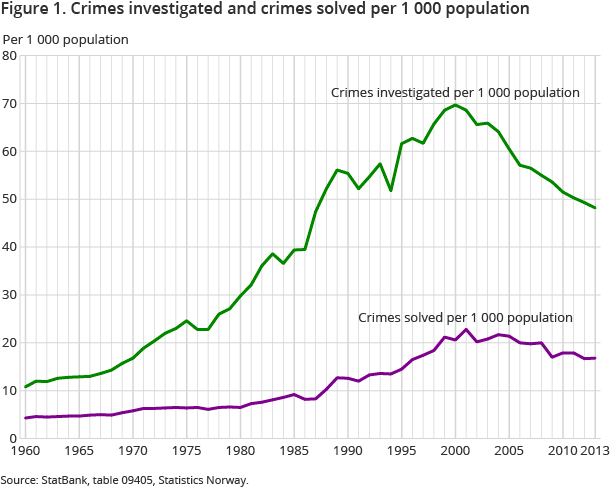
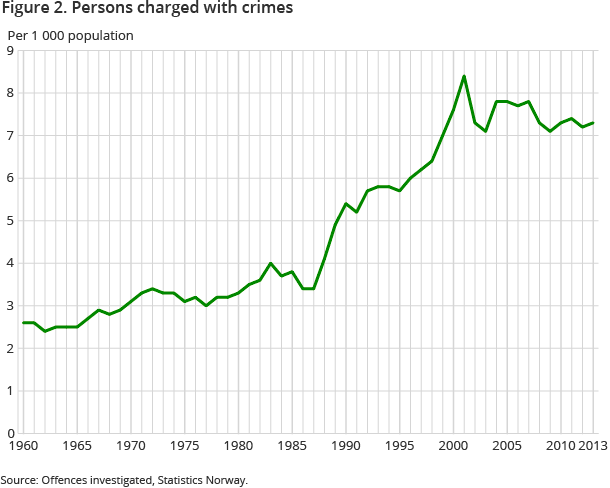
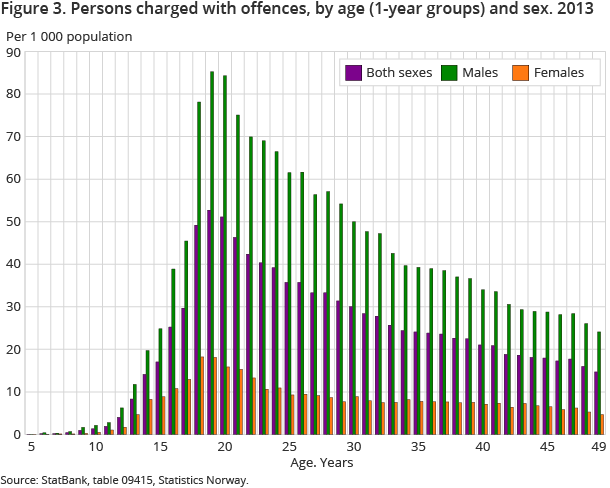
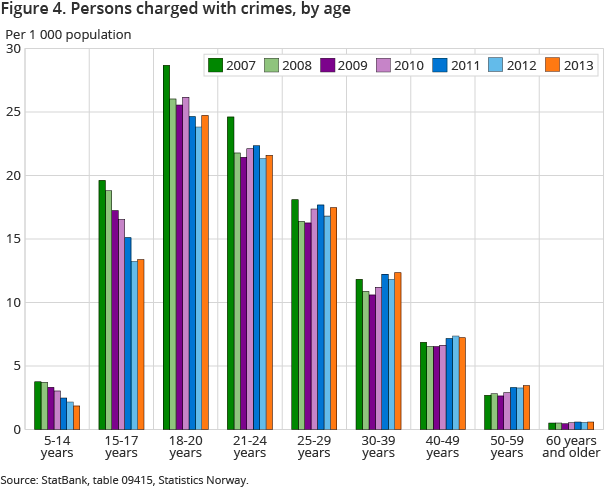
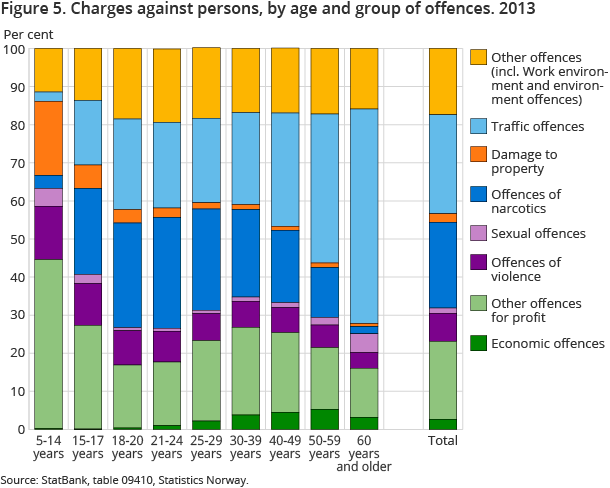
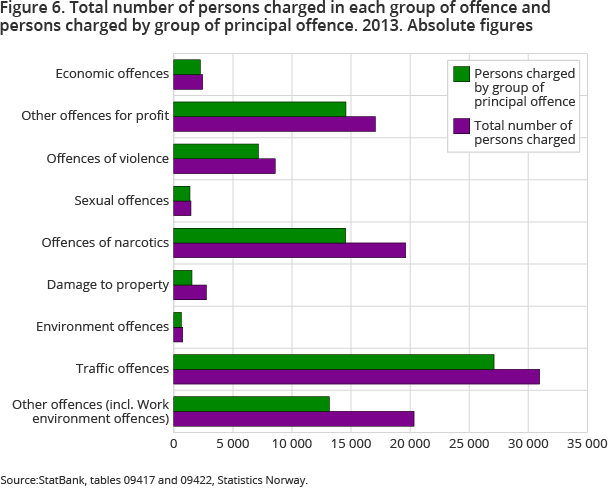
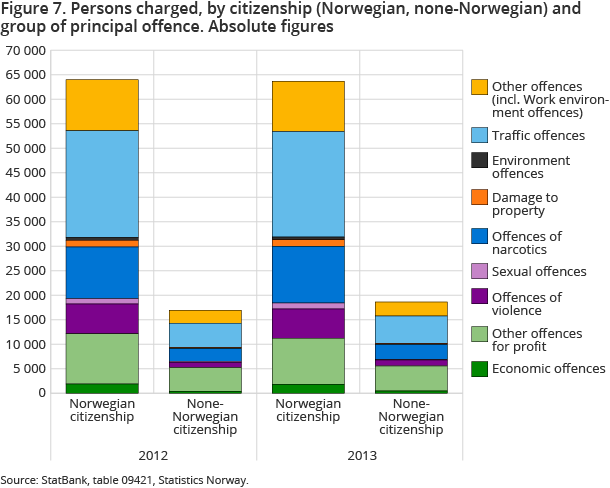
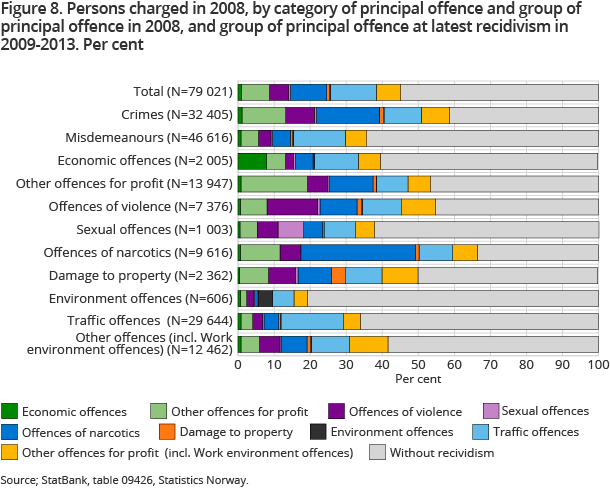
Of the 357 100 completed offences investigated in 2013, 246 200 were crimes and 110 900 were misdemeanours. This is 2 700 fewer crimes and about the same number of misdemeanours as in 2012.
Compared to the previous year, there were almost 12 per cent more investigated offences of narcotics than in 2013. For traffic offences, offences of violence and damage to property, which are other groups with a significant number of reported and investigated offences, the number was at a corresponding level as the previous year. The number of completed investigated thefts and other offences for profit was, however, 4 per cent lower than in 2012.
Fewer thefts
The 158 300 completed investigated offences for profit in 2013 was 6 800 fewer than in the previous year, and the lowest since 1998.
In total, there were 5 600 fewer aggravated thefts than in the previous year, and there was a drop for all types of aggravated theft that are grouped in the statistics. In absolute numbers, the drop was greatest for the category “other aggravated larceny”, where the 23 050 offences are 2 550 fewer than in 2012. This drop is mostly related to a reduction in incidents of aggravated larceny from a person in a public place. The 2 450 fewer incidents of the most serious aggravated larcenies from cars and other means of transport also contributed to the drop in the total number of completed investigated offences for profit.
More offences of narcotics
In total, there were almost 45 500 completed investigated offences of narcotics in 2013. This is about 4 800 more than in 2012, and the highest number since 1998. In terms of numbers, the increase was approximately the same for the less serious violations of the Act relating to medicines etc. as for the types of offences of narcotics that are classified as a crime under the Penal Code.
Given that many of the thefts and drug cases have a relatively short turnaround by the police and prosecutors, several of these main features of crime developments are seen in the statistics on offences reported to the police .
More solved and fewer unsolved offences
Of all offences investigated in 2013, 172 000 were regarded as solved and 185 100 as unsolved. This constitutes 1 per cent more solved offences and over 2 per cent fewer unsolved offences than in 2012.
Large disparities in the share of dismissed and solved types of offences
Whether an offence is solved or not, and which legally binding decisions are made, vary substantially for the various groups of offences and types of offences. The share of solved crimes in total was 84 per cent in 2013. This is slightly lower than in 2012, but offences of narcotics are still the group of offences with the highest share of solved cases. Other offences for profit and damage to property are the two groups of offences that have the lowest share of solved cases, with about 20 per cent in 2013.
Of all 123 400 larcenies investigated in 2013, 13 400 resulted in prosecution, a ticket fine or another decision classified as solved. The total number of solved larcenies was thus at the same historically low level as in 2012 . Of all larcenies investigated in 2013, 84 per cent were dismissed due to lack of information on the perpetrator. A total of 110 000 thefts were regarded as unsolved, which is more than 5 per cent lower than in the previous year.
More violations of the Act relating to medicines etc. led to higher share solved
In 2013, almost 78 per cent of all misdemeanours and 35 per cent of all crimes were solved. The share of solved crimes in total was thus one percentage point higher than in 2012. Disparities in the composition of reported and completed investigated types of offences are, however, of great importance for many of the changes in the share of solved cases as we see from year to year.
For instance, almost the entire increase of the share of solved crimes from 2012 occurred because of changes in the scope of reported and investigated offences of narcotics and offences for profit. More specifically, the increase in the number of reported and investigated violations of the Act relating to medicines etc. made the largest contribution to the overall increase in the share of solved crimes from 2012 to 2013. The decrease in the number of reported cases of aggravated larceny, and especially aggravated larceny from a person in a public place and other types of larcenies that are usually not solved, contributed greatly to this.
Fewer charges and persons charged, especially for offences of narcotics
In 2013, investigations by the police and prosecution authorities resulted in a total of 174 700 charges against 82 300 different persons. That is almost 1 200 more charges and 1 350 more persons charged than in 2012.
The increase was largest for offences of narcotics. A total of 19 600 persons had more than 39 300 charges against them for offences of narcotics in 2013. Thisis 9 and 8 per cent more than in 2012 respectively. A considerably high share of these persons charged for offences of narcotics, 26 per cent, is also charged with other offences that have a higher sentencing framework. These are classed under another principal offence group, and hence, 14 500 persons were charged with an offence of narcotics as their principal offence , as illustrated in figure 6. This is 1 450 more than in 2012, and a considerably higher number than in all previous years for which statistics are available. The increase, and the historically high numbers, relate to persons charged with violations of the Penal Code and persons charged with violations of the Act relating to medicines etc. Persons charged with offences of narcotics as their principal offence made up 39 per cent of all persons charged with crimes in 2013.
Increasing number of youths charged with drug offences
As many as 84 per cent of those charged with offences of narcotics as their principal offence in 2013 are men. The increase from 2012 is clearly greater for men than for women. Relative to the size of the previous year, the increase is greatest among youths in the age group 15-20 years, with almost 22 per cent more persons charged. The increase is larger for persons with Norwegian citizenship, but in terms of percentage, the increase was larger for the group with non-Norwegian citizenship. In 2013, those with non-Norwegian citizenship made up one fifth of all persons charged with drug offences as their principal offence.
Fewer charged with offences for profit
A total of 14 600 persons had offences for profit as their principal offence in 2013. This is more than 3 per cent fewer than in 2012 and more than 10 per cent fewer than in 2009.
The breakdown of charged persons into the more detailed types of crimes for profit varies somewhat from year to year. The reduction between 2012 and 2013 is mostly due to a reduction in the number of reported and persons charged for misdemeanours under the Duty Act . A total of 1 074 persons were charged with smuggling (misdemeanour) as their principal offence in 2013, which is 26 per cent fewer than in 2012. There were also fewer persons charged with thefts from dwellings and holiday homes. The 563 persons with these types of thefts as their principal offence in 2013 correspond to 17 per cent fewer than in the previous year. In addition, the drop in the number of persons charged with larcenies from cars and other means of transport as their principal offence continued in 2013.
On the other hand, the 957 persons charged in the category ‘Other aggravated larceny’ corresponded to 19 per cent more than in 2012. This increase is mostly related to 116 more persons charged with aggravated larceny from a person in a public place as their principal offence.
Further decrease in violence among youths
In 2013, investigations of almost 24 900 violent offences were completed. Of these, 11 500 are regarded as unsolved. The almost 13 400 solved offences of violence resulted in 13 000 charges against 8 600 persons. Out of these charges, 6 272 were for assault, 1 464 for bodily harm, 1 422 for assaulting a public servant, 595 for ill treatment within families (including serious ill treatment) and 2 721 for threats.
Both the total amount of persons charged with violent offences and the number of persons charged with this type of crime as their principal offence was lower in 2013 compared to previous years . The decrease in the number of persons charged with violence as the principal offence was only for men and for the youngest age groups. The decrease was greatest in the age groups 5-14 and 15-17 years, with 20 and 14 per cent fewer persons charged, respectively. The decrease in violent offences among the younger age groups during these years can also be seen in the statistics on victims of offences reported to the police and in the mapping of violence in the survey of living conditions .
The share of men is lower than in the previous year, but 86 per cent of all persons charged with violent offences are still men.
Most persons charged in the age group 18-20 years
As in previous years, youths in the age group 18-20 years are still most overrepresented among persons charged, both for crimes and misdemeanours and for both sexes. As shown in figure 3, men are far more often charged for offences than women, and of all persons charged for offences in 2013, 84 per cent were men.
During the previous five-year period, there was a major drop in the number of persons charged among the youngest age groups. This trend did not continue for the age group 15-20 years, mainly because of the growing number of persons charged with offences of narcotics. As can be seen in figure 4, there were even fewer persons charged with crimes in the age group 5-14 years in 2013.
More foreign citizens charged with offences for profit and traffic offences
Of those charged in 2013, 18 600 had non-Norwegian citizenship, and this is almost 1 700 more than in the previous year. Classified by offence group, 600 more persons were charged with traffic offences and 300 more persons were charged with offences for profit, as illustrated in figure 7.
In addition to the Norwegian citizens and the foreign citizens resident in Norway, there are also others who stay in Norway for shorter or longer periods of time and are charged with offences. The number of charged persons who are registered as a resident of another country has increased in recent years, and this group made up over 8 per cent of all persons charged with offences in 2013.
The total increase in the number of persons with foreign citizenship charged from 2012 to 2013 was almost 10 per cent. In comparison, the increase in foreign nationals in the population has been at the same level during the past years.
Lower share with recidivism
The statistics on recidivism among residents in Norway indicate that 45 per cent of the 79 000 persons charged in 2008 were charged once or more during the subsequent five-year period. This share has decreased gradually in the recidivism surveys in the last six years. For those charged in 2002 it was almost 50 per cent.
Classified by offence group, the highest rate of recidivism is among those charged with offences of narcotics as their principal offence. As illustrated in figure 8, almost 67 per cent of the 9 600 persons charged with offences of narcotics in 2008 were charged once or more during the subsequent five-year period. The corresponding share among those charged with violent offences or offences for profit was 55 per cent and 53 per cent respectively. Of all persons charged with sexual offences in 2008, 38 per cent were charged once or more during the years from 2008-2013.
Still highest rate of recidivism among men
In the last recidivism survey, 48 per cent of all men and 30 per cent of all women were repeat offenders. The share of repeat offenders falls substantially with age among men. Among charged women, the disparities between the various age groups are much less pronounced than among the men.
As in previous years, the rate of recidivism is highest among men in the age group 15-17 years, where 63.99 per cent of the 5 254 persons charged in 2008 were registered with recidivism in the years 2009-2013. This is, however, lower than in previous surveys, and is the lowest share with recidivism in this group since 1997.
Contact
-
Reid Jone Stene
E-mail: reid.jone.stene@ssb.no
tel.: (+47) 99 02 22 01
-
Siri Fjærtoft Fossanger
E-mail: siri.fossanger@ssb.no
tel.: (+47) 99 72 49 27
-
Sigmund Book Mohn
E-mail: sigmund.mohn@ssb.no
tel.: (+47) 94 32 77 22
